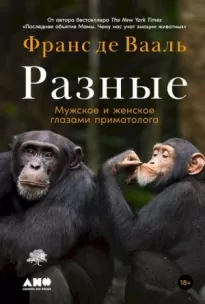Разные. Мужское и женское глазами приматолога

- Автор: Франс де Вааль
- Жанр: Научно-популярная литература
- Дата выхода: 2023
Читать книгу "Разные. Мужское и женское глазами приматолога"
—. 2013.
—. 2016.
—. 2019.
de Waal, F. B. M., and K. E. Bonnie. 2009. In tune with others: The social side of primate culture. In
de Waal, F. B. M., K. Leimgruber, and A. R. Greenberg. 2008. Giving is self-rewarding for monkeys.
de Waal, F. B. M., and L. M. Luttrell. 1985. The formal hierarchy of rhesus monkeys: An investigation of the bared-teeth display.
de Waal, F. B. M., and J. J. Pokorny. 2008. Faces and behinds: Chimpanzee sex perception.
de Waal, F. B. M., and S. D. Preston. 2017. Mammalian empathy: Behavioral manifestations and neural basis. Nature Reviews:
de Waal, F. B. M., and A. van Roosmalen. 1979. Reconciliation and consolation among chimpanzees.
Deaner, R. O., S. M. Balish, and M. P. Lombardo. 2015. Sex differences in sports interest and motivation: An evolutionary perspective.
Deardorff, J., et al. 2010. Father absence, body mass index, and pubertal timing in girls: Differential effects by family income and ethnicity.
Demuru, E., et al. 2020. Foraging postures are a potential communicative signal in female bonobos.
Demuru, E., P. F. Ferrari, and E. Palagi. 2018. Is birth attendance a uniquely human feature? New evidence suggests that bonobo females protect and support the parturient.
Demuth, S., and S. L. Brown. 2004. Family structure, family processes, and adolescent delinquency: The significance of parental absence versus parental gender.
Denworth, L. 2020
Derks, B., et al. 2018. De keuze van vrouwen voor deeltijd is minder vrij dan we denken.
Derntl, B., et al. 2010. Multidimensional assessment of empathic abilities: Neural correlates and gender differences.
Despret, V. 2009. Culture and gender do not dissolve into how scientists «read» nature: Thelma Rowell's heterodoxy. In
Diamond, J. 1992.
Diamond, M., and H. K. Sigmundson. 1997. Sex reassignment at birth: Longterm review and clinical implications.
Dienske, H., W. van Vreeswijk, and H. Koning. 1980. Adequate mothering by partially isolated rhesus monkeys after observation of maternal care.
Diogo, R., J. L. Molnar, and B. Wood. 2017. Bonobo anatomy reveals stasis and mosaicism in chimpanzee evolution, and supports bonobos as the most appropriate extant model for the common ancestor of chimpanzees and humans
DiPietro, J. A. 1981. Rough and tumble play: A function of gender.
Dixon, A. 2010. Homosexual behaviour in primates. In
Eckes, T., and H. M. Trautner, eds. 2000.
Edwards, C. P. 1993. Behavioral sex differences in children of diverse cultures: The case of nurturance to infants. In
Edwards, C. P. 2005. Children's play in cross-cultural perspective: A new look at the six cultures study.
Ehmann, B., et al. 2021. Sex-specific social learning biases and learning outcomes in wild orangutans.
Ellis, B. J., et al. 2003. Does father absence place daughters at special risk for early sexual activity and teenage pregnancy?
Fagen, R. 1993. Primate juveniles and primate play. In
Fairbanks, L. 2000. Maternal investment throughout the life span in Old World monkeys. In
Fairbanks, L. A. 1990. Reciprocal benefits of allomothering for female vervet monkeys.
—. 1993. Juvenile vervet monkeys: Establishing relationships and practicing skills for the future. In
Fausto-Sterling, A. 1993. The five sexes: Why male and female are not enough. Sciences 33:20–24.
Fedigan, L. M. 1982.
—. 1994. Science and the successful female: Why there are so many women primatologists.
Feldblum, J. T., et al. 2014. Sexually coercive male chimpanzees sire more offspring.
Feldman, R., K. Braun, and F. A. Champagne. 2019. The neural mechanisms and consequences of paternal caregiving.
FeldmanHall, O., et al. 2016. Moral chivalry: Gender and harm sensitivity predict costly altruism.
Finch, C. 2016. Compassionate ostrich offers comfort to baby elephants at orphaned animal sanctuary.
Flack, J. C., D. C. Krakauer, and F. B. M. de Waal. 2005. Robustness mechanisms in primate societies: A perturbation study.
Flanagan, J. 1989. Hierarchy in simple «egalitarian» societies.
Flemming, A. S., et al. 2002. Mothering begets mothering: The transmission of behavior and its neurobiology across generations.
Flores, A. R., et al. 2016.
Foerster, S., et al. 2016. Chimpanzee females queue but males compete for social status.
Ford, C. S., and F. A. Beach. 1951.
Forman, J., et al. 2019. Automobile injury trends in the contemporary fleet: Belted occupants in frontal collisions.
Forrester, G. S., et al. 2019. The left cradling bias: An evolutionary facilitator of social cognition?
Foster, M. W., et al. 2009. Alpha male chimpanzee grooming patterns: Implications for dominance «style.»
Fraser, O. N., and F. Aureli. 2008. Reconciliation, consolation and postconflict behavioral specificity in chimpanzees.
French, M. 1985.
Frumin, I., et al. 2015. A social chemosignaling function for human handshaking.
Fry, D. P. 2006.
—. 2013.
Fujita, S., and E. Inoue. 2015. Sexual behavior and mating strategies. In
Furuichi, T. 2019.
Furuichi, T., et al. 2014. Why do wild bonobos not use tools like chimpanzees do?
Galdikas, B. M. F. 1995.
Ganna, A., et al. 2019. Large-scale GWAS reveals insights into the genetic architecture of same-sex sexual behavior.
Garcia-Falgueras, A., and D. F. Swaab. 2008. A sex difference in the hypothalamic uncinate nucleus: Relationship to gender identity.
Gavrilets, S., and W. R. Rice. 2006. Genetic models of homosexuality: Generating testable predictions.
Ghiselin, M. 1974.
Goldfoot, D. A., et al. 1980. Behavioral and physiological evidence of sexual climax in the female stump-tailed macaque.
Goldhagen, D. J. 1996.
Goldsborough, Z., et al. 2020. Do chimpanzees console a bereaved mother?
Goldstein, J. S. 2001
Goodall, J. 1979. Life and death at Gombe.
—. 1986
Gould, S. J. 1977.
—. 1993. Male nipples and clitoral ripples.
Gowaty, P. A. 1997. Introduction: Darwinian Feminists and Feminist Evolutionists. In
Gowaty, P. A., Y.-K. Kim, and W. W. Anderson. 2012. No evidence of sexual selection in a repetition of Bateman's classic study of Drosophila melanogaster.
Grammer, K., L. Renninger, and B. Fischer. 2005. Disco clothing, female sexual motivation, and relationship status: Is she dressed to impress?
Grawunder, S., et al. 2018. Higher fundamental frequency in bonobos is explained by larynx morphology.
Gray, J. 1992.
Greenberg, D. 1988.
Gülgöz, S., et al. 2019. Similarity in transgender and cisgender children's gender development.
Gutmann, M. C. 1997. Trafficking in men: The anthropology of masculinity.
Haig, D. 2004. The inexorable rise of gender and the decline of sex: Social change in academic titles, 1945–2001. Archives of Sexual Behavior 33:87–96.
Hall, J. A. 2011. Sex differences in friendship expectations: A meta-analysis.
Hall, K. R. L., and I. DeVore. 1965. Baboon social behavior. In
Hallal, P. C., et al. 2012. Global physical activity levels: Surveillance progress, pitfalls, and prospects.
Halley, J. E. 1994. Sexual orientation and the politics of biology: A critique of the argument from immutability.
Haraway, D. 1989.
Harlan, R. 1827. Description of a hermaphrodite orang outang.
Harris, J. R. 1998.
Harrison, J., et al. 2011. Belzec, Sobibor, Treblinka: Holocaust Denial and Operation Reinhard.
Haselton, M. G., et al. 2007. Ovulatory shifts in human female ornamentation: Near ovulation, women dress to impress.
Hassett, J. M., E. R. Siebert, and K. Wallen. 2008. Sex differences in rhesus monkey toy preferences parallel those of children.
Hawkes, K., and J. E. Coxworth. 2013. Grandmothers and the evolution of human longevity: A review of findings and future directions.
Hayes, C. 1951.
Hecht, E. E., et al. 2021. Sex differences in the brains of capuchin monkeys.
Henrich, J., and F. J. Gil-White. 2001. The evolution of prestige: Freely conferred deference as a mechanism for enhancing the benefits of cultural transmission.
Herman, R. A., M. A. Measday, and K. Wallen. 2003. Sex differences in interest in infants in juvenile rhesus monkeys: Relationship to prenatal androgen.
Herschberger, R. 1948.
Hesse, M. 2019. Elizabeth Holmes's weird, possibly fake baritone is actually her least baffling quality.
Hill, S. E., R. P. Proffitt Levya, and D. J. DelPriore. 2016. Absent fathers and sexual strategies.
Hines, M. 2011. Gender development and the human brain.
Hockings, K. J., J. R. Anderson, and T. Matsuzawa. 2006. Road crossing in chimpanzees: A risky business.
Hockings, K. J., et al. 2007. Chimpanzees share forbidden fruit.
Hohmann, G., and B. Fruth. 2011. Is blood thicker than water? In
Hopkins, W. D. 2004. Laterality in maternal cradling and infant positional biases: Implications for the development and evolution of hand preferences in nonhuman primates.
Hopkins, W. D., and M. de Lathouwers. 2006. Left nipple preferences in infant Pan paniscus and P. troglodytes
Hoquet, T., et al. 2020. Bateman's data: Inconsistent with «Bateman's Principles.»
Horner, V., and F. B. M. de Waal. 2009. Controlled studies of chimpanzee cultural transmission.
Horner, V., D. J. Carter, M. Suchak, and F. B. M. de Waal. 2011. Spontaneous prosocial choice by chimpanzees.
Horner, V., et al. 2010. Prestige affects cultural learning in chimpanzees.
Hrdy, S. B. 1977.
—. 1981.
—. 1999.
—. 2000. The optimal number of fathers: Evolution, demography, and history in the shaping of female mate preferences.
—. 2009.
Hyde, J. S., and J. DeLamater. 1997.
Hyde, J. S., et al. 2008. Gender similarities characterize math performance.
Idani, G. 1990. Relations between unit-groups of bonobos at Wamba, Zaire: Encounters and temporary fusions.
—. 1993. A bonobo orphan who became a member of the wild group.
Jabbour, J., et al. 2020. Robust evidence for bisexual orientation among men.
Jadva, V., M. Hines, and S. Golombok. 2010. Infants' preferences for toys, colors, and shapes: Sex differences and similarities.





